String of pearls plants look like they would be hard to grow, but they are surprisingly easy to care for. In this complete guide, I’ll tell you all you need to know in order to keep them thriving for decades to come.
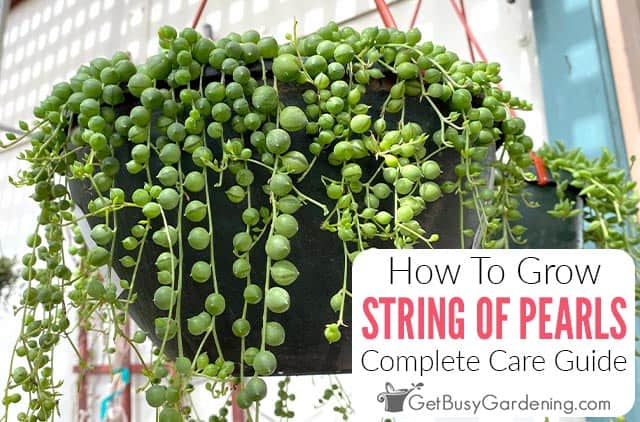
Whether you’re after something low-maintenance or looking for a truly unique houseplant, the quirky string of pearls is just what you need.
It’s perfect for beginners and adds a focal point to any room. They’re a popular choice for hanging baskets or a high shelf where the vines can drape over the edge.
With the right care, they can even be passed on for generations, just like grandma’s pearl necklace.
In this string of pearls care guide I’ve shared everything you need to know about to grow them well.
Learn about watering, soil, light, propagation, repotting, pruning, pest control, and so much more, all in this complete guide.
String Of Pearls Quick Care Overview
| Scientific name: | Curio rowleyanus |
| Classification: | Succulent |
| Common names: | String of pearls, string of beads |
| Hardiness: | Zones 9-11 |
| Temperature: | 55-85°F |
| Flowers: | White flowers, blooms fall-winter |
| Light: | Partial shade |
| Water: | Allow soil to dry between waterings, do not overwater |
| Humidity: | Little to none |
| Fertilizer: | General purpose plant food in spring and summer |
| Soil: | Fast-draining, sandy soil |
| Common pests: | Aphids, mealybugs |
What Is A String Of Pearls Plant?
String of pearls (Curio rowleyanus), sometimes called string of beads, is a beautiful trailing succulent plant that has a very unique growth habits.
It’s a shallow rooted plant native to Africa that produces long stems with fleshy, pea-shaped round leaves.
The long, draping stems are popular in hanging baskets, especially paired with other plants to create beautiful diverse foliage. Some gardeners have string of pearls that are 5’ long and growing!
They require little hands-on care and infrequent watering, which makes them ideal for beginners or even those of you who claim to have brown thumbs.
String Of Pearls Varieties
The variegated variety is the only other true string of pearls. It’s leaves feature splashes of cream and sometimes pink.
There are a few similar variations that are related and require the same care, but have different leaves.
Examples include Senecio herreianus, which has oval leaves that come to a near point. And string of bananas, which has longer hooked-shaped leaves.
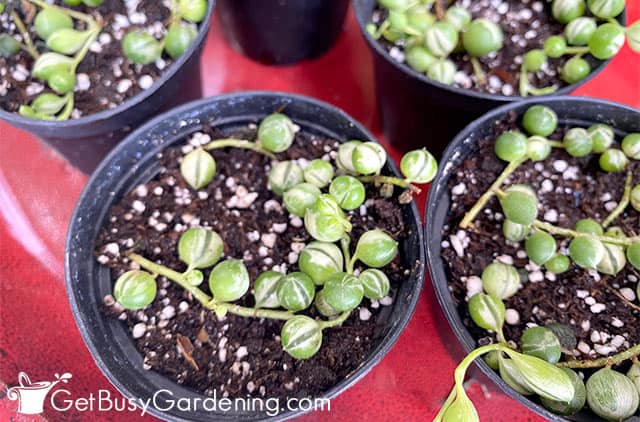
Flowers
String of pearls is most often grown for its foliage. But the unique and dainty blossoms it produces in the summer are a highlight loved by those who have them.
To encourage flowering, they’ll need the right conditions in the winter when they go semi-dormant. Keep them at a constant 60°F, and reduce watering.
In the summer, small white round flowers with beautiful, colorful stamens will bloom for about 6 weeks.
But the blossoms, while pretty, are most admired for their gentle fragrance. Many describe it as subtly spicy, like cinnamon or clove.
How To Grow String Of Beads
Before we talk about string of pearls care, first let’s chat about the best place to grow them. Choosing the right location is the first step in keeping them healthy.
Hardiness
String of beads are not frost tolerant, and prefer temperatures above 50°F. When it falls below that they’ll suffer, and the cold will eventually kill them.
They’re hardy outdoors only in the warmer zones of 9-11. Outside of those areas, they need to be kept as houseplants.
Where To Grow Curio rowleyanus
In warmer climates, Curio rowleyanus grows well outdoors in a partially shaded spot protected from the hot afternoon sun, which can burn the leaves.
For the rest of us, they’re excellent houseplants year round. Place them near a sunny window or in the brightest room of your home for the best results.
If you want, you can move it outdoors for the summer when nighttime temperatures are above 50°F. Just be sure to move it back indoors several weeks before your first frost date.
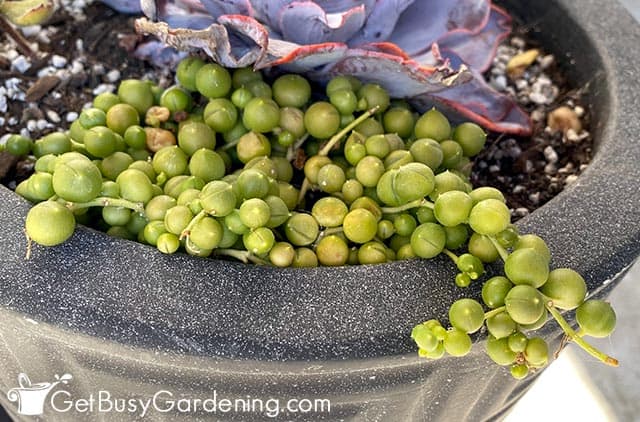
String Of Pearls Plant Care & Growing Instructions
With the perfect place in mind for your string of pearls, it’s time to learn how to care for it. They don’t need much hands-on attention, and will thrive with a little controlled neglect.
Light
Whether they’re grown indoors or out, string of beads love filtered light but not full sun.
Direct sun in the morning and evening is fine, but protect them from the hot afternoon rays to prevent browning and scorching.
Bright, indirect light is great as well, but low-light settings can cause leggy, sparse growth along the stems.
Add a grow light if you don’t have much natural sun in your home, or you notice they are starting to stretch towards the window.
Water
The ability to store water in the leaves and stems is what makes string of pearls drought-tolerant. They’ll only need a drink when the top ½” of soil is dry to the touch.
Water deeply, until it drips from the drainage holes. Then, discard any excess from the tray so they never sit in it, or the roots may rot.
The leaves are actually excellent at telling us what they need. If they lose the rounded shape and begin to flatten or shrivel, they’re dehydrated.
If they become mushy or dark, you’ve overwatered and the soil needs to dry out more.
If it’s a struggle for you to get right, a soil moisture gauge is an inexpensive tool that will be a big help.
Related Post: How To Water A Succulent Plant

Temperature
String of pearls are not very cold hardy. They prefer temperatures in the 55-85°F range, and can suffer when it drops too much below that. Give them shade and more frequent water in higher temps.
Keep them away from drafty spots and cold air as well. That’s a common reason for dropping leaves.
In the winter, keep them at a steady 60°F and reduce water to trigger a partial dormancy that encourages those fragrant summer flowers.
Fertilizer
It’s not necessary to fuss over fertilizing as part of your regular string of pearls care routine. But an occasional, diluted feedings of liquid plant food can encourage faster, fuller growth.
Use a cacti and succulent fertilizer or a general purpose one to feed them in the spring and summer.
I recommend using natural, organic options like these over synthetic ones, which can damage and burn them.
Apply only a weak dose in the spring so it’s not overwhelmed. Then, stop fertilizing completely in the fall and winter.
Soil
It’s important to use a well-draining, aerated soil that won’t retain too much moisture for growing your string of pearls.
You can use any cacti potting mix, but a sandy one that most closely replicates their native soil is the best choice.
If you want, you can make your own by combining equal parts of a general purpose mix with perlite and coarse sand.
Repotting
As long as your string of pearls is growing well in its current container, repotting is not needed as part of their regular care.
You’ll know it’s time when growth slows noticeably, the plant is completely root-bound, or roots are coming out of the holes in the bottom.
The best time to repot is in the spring. Choose a container that is only 1-2” larger than the current one and has drainage holes in it.
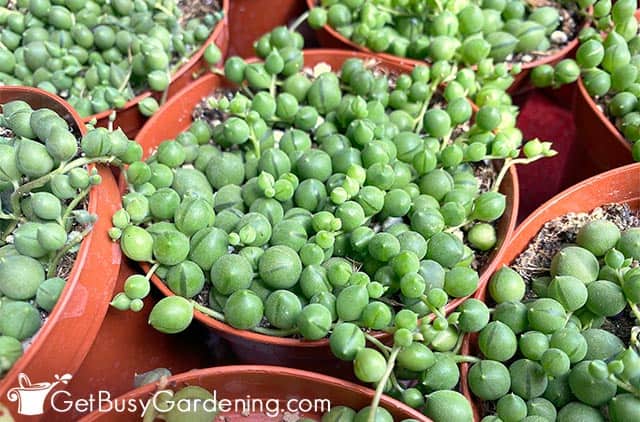
Pruning
It’s never required to prune your string of pearls. But it’s a good way to remove leggy and discolored stems, or manage the length. It also encourages fuller, more compact growth.
The best time to trim them is in the spring. Use a sharp, clean pair of micro snips or precision pruners to clip the stems above dead or discolored sections, or where the vines are too long.
Pest Control Tips
Though a healthy string of pearls doesn’t often get bugs, mealybugs and aphids can sometimes become a problem. These annoying pests can be treated in several ways.
Spray neem oil on all sides of the leaves to kill and prevent recurring infestations. Don’t skip the underside of the vines or near the base of the stems where these pests can hide.
A natural insecticidal soap is also very effective. You can also try making your own by combining 1 teaspoon of mild liquid soap with 1 liter of water.
For immediate help, dip a cotton swab in rubbing alcohol and apply it directly to the bugs to kill and remove any that you see.
String Of Pearls Propagation Tips
Curio rowleyanus is actually very easy to propagate by either cuttings or division. It’s a fun project to tackle after spring pruning, and a great way to extend the life of your plant for decades.
Roots will form from either exposed leaf nodes on a vine cutting, or from the pearls themselves. So, you have options!
Pick off several leaves, then place them on top of well-draining soil with the cut end facing down.
Or, simply lay a vine cutting on top and gently pin it down. Roots will form on the underside of the leaves.
Either way, using a rooting hormone is a great way to encourage faster, hardier roots. Place them warm in a bright location, and keep the soil barely moist until new growth begins. Get the full step-by-step tutorial here.
Troubleshooting Common Problems
Below are some tips for fixing the most common string of pearls plant care issues. While they’re pretty easy to grow, you may experience some of these common problems over the years.
Shriveled leaves
Shriveled or flattened leaves mean your plant is thirsty. The round leaves store water and when they run out, the shape becomes deflated.
Stick your finger one inch into the soil. If it feels dry, it’s time to water. Try to avoid letting it go bone dry for long periods to keep them healthy, green, and plump.
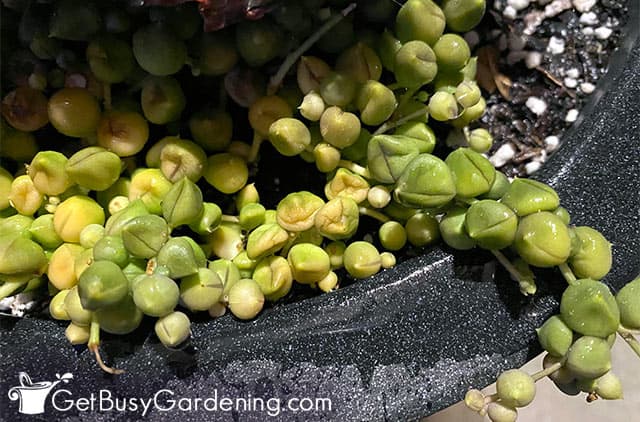
Leaves turning yellow
Yellowing leaves on a string of beads is a sign of overwatering. Let the soil dry between drinks, at least ½” down, and only then water thoroughly.
They don’t like wet feet or soggy soil. Always drain off all excess water, and never leave them sitting in it to prevent rot.
Plant not growing
If your string of pearls is not growing, a couple of things could be happening. It may be time to repot, so check if the roots are peeking through the drainage holes.
If you haven’t fertilized in a while, the soil nutrients may also be depleted. Give it a diluted dose of cacti and succulent plant food to stimulate it.
But slow or stalled growth can also mean it’s just not happy where it is. Place it in a bright location, away from drafts or cold air, water when the soil dries out, and don’t expose it to temps below 55°F.
Leaves turning brown
Browning leaves or spots typically mean sunburn. Make sure your Curio rowleyanus isn’t exposed to the afternoon sun indoors, or move it to a more shaded area outdoors.
Go ahead and trim off any brown leaves or stems. Sadly, they won’t heal.
FAQs About String Of Pearls Plants
Here you’ll find the answers to the questions gardeners most commonly have about string of pearls care. If yours isn’t on the list, please ask in the comments section below.
Is string of pearls toxic?
Yes, string of pearls is toxic when ingested according to the ASPCA website. Keep it out of reach of cats, dogs, and small children.
Does a string of pearls flower?
Yes a string of pearls can flower in the summer when given the proper dormancy conditions in the winter. Reduce watering and keep them at a steady 60°F until the spring to help trigger blooming.
Are string of pearls fast-growing?
String of pearls are fast-growing when given the proper care and conditions. Bright light, temperatures between 55-85°F, well-draining soil, and proper watering will encourage faster growth.
Is string of beads the same as string of pearls?
Yes, string of beads is the same as string of pearls. It’s just another common nickname for Curio rowleyanus.
Why does my string of pearls keep dying?
There are unfortunately many reasons that your string of pearls could be dying. Overwatering is the most common cause. But it could also be extreme cold or hot temperatures, long periods of drought, pests, or even old age.
String of pearls are easy to care for and fun to grow. With the tips in this guide, you’re now prepared to provide just the right amount of neglect to help them thrive.
If you want to learn all there is to know about maintaining healthy indoor plants, then you need my Houseplant Care eBook. It will show you everything you need to know about how to keep every plant in your home thriving. Download your copy now!
More Houseplant Care Guides
- How To Care For Firestick Plant (Euphorbia tirucalli ‘Sticks Of Fire’)
- How To Care For String Of Hearts (Ceropegia woodii)
- How To Care For Fishbone Cactus (Selenicereus anthonyanus)
- How To Grow & Care For Echeveria Plants
- How To Care For Kalanchoe Plants
- How To Care For Mother Of Millions Plant (Kalanchoe delagoensis)
Share your string of pearls care tips in the comments section below!
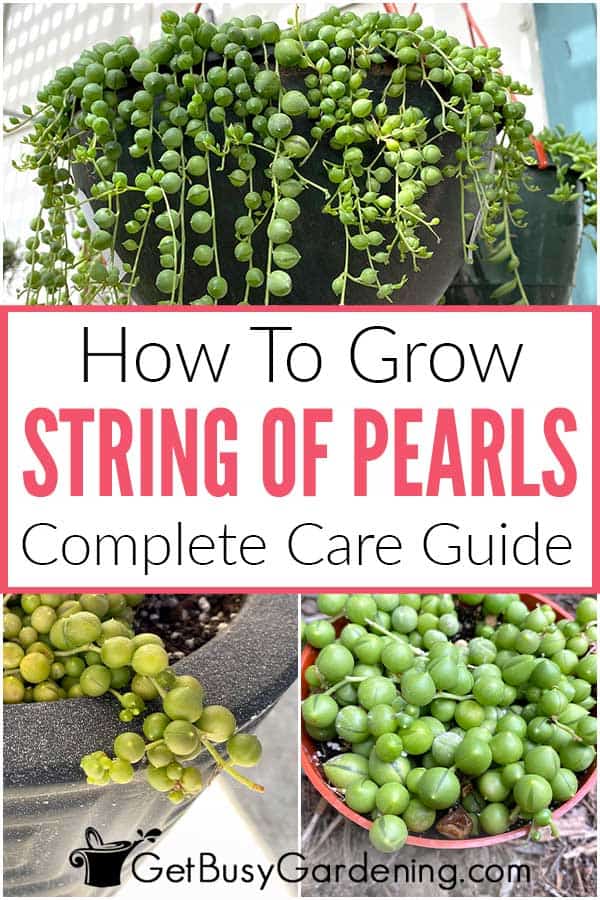
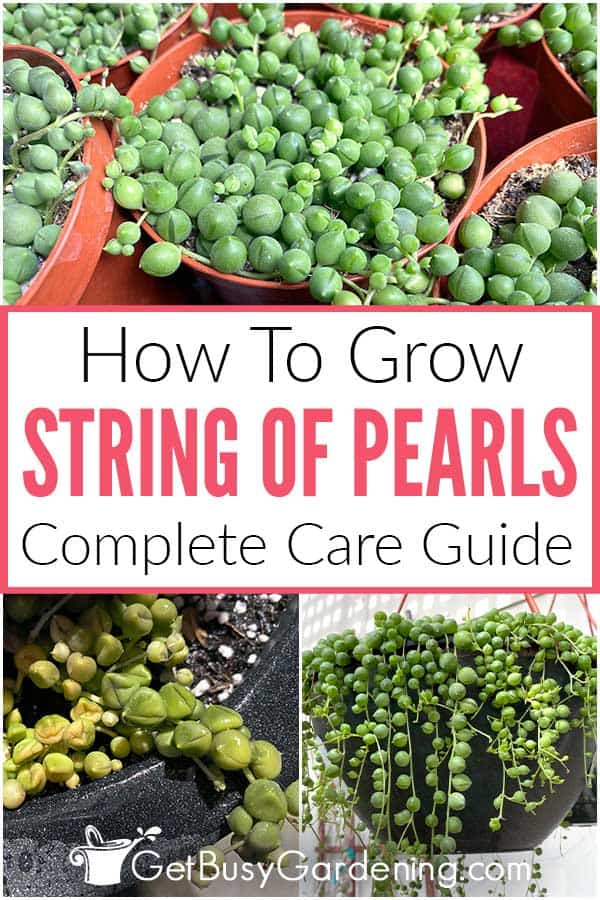
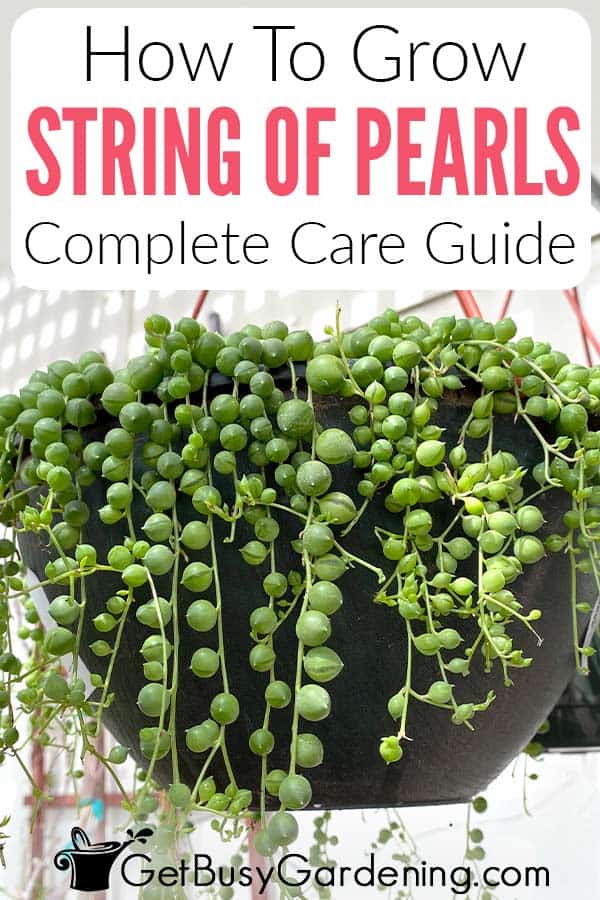



Leave a Reply